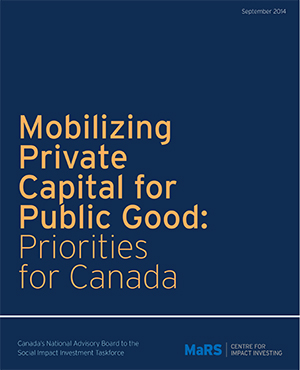Focused on directing private capital into projects and ventures whose aims are to deliver measurable social outcomes, impact investment (or social finance) has the potential to foster innovation in the social sector. It is spurring new forms of non-profit, private and public sector collaboration, and is being used to develop and test new ideas for tackling social challenges and to scale up those that work.
Impact investing in Canada is on the rise, but it will require leadership from governments, foundations, pension funds, entrepreneurs, non-profit organizations (NPOs) and others to reach its full potential. This report advances priority recommendations for governments—the federal government in particular—to enable and catalyze impact investment in Canada.
Key recommendations:
- Enable impact investment and social entrepreneurship in the charitable and non-profit sector, in particular by updating the Income Tax Act and related guidance, which have not kept pace with these trends.
- Establish an impact investing matching program, paired with appropriate incentives such as credit enhancements, guarantees and tax advantages, which have been used to good effect to attract investment to other markets in support of public policy priorities.
- Establish an outcomes payment fund, specifying maximum prices that the government will pay for certain outcomes, allowing the market to respond with innovative solutions. Social service providers, in turn, can gain access to impact investment capital based on the government’s commitment to pay when outcomes are achieved.
This report was developed under the auspices of the Social Impact Investment Taskforce, which was launched by Prime Minister David Cameron in June 2013 at the G8 Social Impact Investment Forum in London, under the Chairmanship of Sir Ronald Cohen. It was informed by a group of 24 Canadian experts, from the private, non-profit and academic sectors (the Canadian “National Advisory Board”) and builds on the 2010 report of the Canadian Task Force on Social Finance.
The reports of the Social Impact Investment Taskforce, other National Advisory Boards and Taskforce working groups on impact measurement, asset allocation, mission alignment and international development are available here.
Table of Contents
Introduction and Executive Summary
Building from a rich history
What is impact investment?
Part of a broader impact investment agenda
Organization of the report
Summary of recommendations
Conclusion
Part 1: Rethinking the non-profit / for-profit divide: Income Tax Act barriers to social entrepreneurship and impact investment in the non-profit and charitable sector
1. Introduction
2. Background
2.1 Charities and NPOs
2.2 Impact investment and social entrepreneurship
3. ITA restrictions on social entrepreneurship: Revenue generating activity and the public benefit test
3.1 Charities: Operating a “related business”
3.2 Charities: Public benefit test
3.3 NPOs: Restrictions on earning a profit
3.4 ITA restrictions on social entrepreneurship: The challenge
3.5 ITA restrictions on social entrepreneurship: The opportunity
4. Restrictions on impact investment
4.1 Impact investments
4.2 Investments in limited partnerships
4.3 Restrictions on impact investment: The challenge
4.4 Restrictions on impact investment: The opportunity
5. Recommendations
5.1 Recommendation 1: Enable charitable and NPO social enterprise activity
5.2 Analysis of potential risks and costs
5.3 Recommendation 2: Unlock foundation capital for impact investing
5.4 Analysis of potential risks and costs
5.5 Supporting recommendations
6. Conclusion
Annex A: Organizational structures for social enterprises in Canada
Annex B: Case studies
Annex C: International and domestic models
Part 2: Catalyzing impact investing: the opportunity for governments
1. Introduction
2. Scope and limitations
3. Snapshot of impact investing in Canada
4. The opportunity to stimulate the investment of private capital
5. Government interest in impact investing in Canada
6. The role of the government as a catalyst
7. Government initiatives to catalyze impact investing
7.1 Credit enhancements
7.2 Tax incentives
7.3 Direct capital investment
7.4 Direct payment for outcomes
8. Recommendations
8.1 Recommendation 3: Establish an impact investing matching program, paired with appropriate incentives.
8.2 Recommendation 4: Establish an outcomes payment fund
8.3 Supporting recommendations
9. Conclusion





